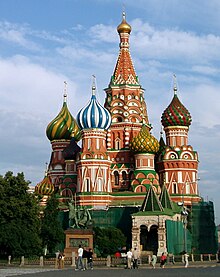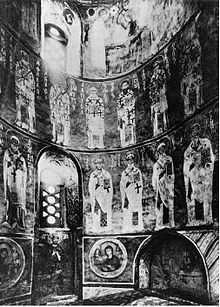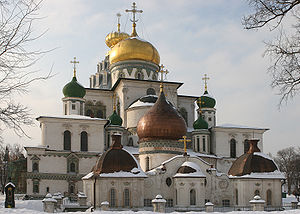This is an old revision of this page, as edited by Andrew Alexander (talk | contribs) at 16:26, 11 November 2005 (→Pre-Mongol period (988–1230): Sticking to "pure Russian", e.g. Russian, architecture. Removed references to non-Russian architecture, claimed to belong to Russia.). The present address (URL) is a permanent link to this revision, which may differ significantly from the current revision.
Revision as of 16:26, 11 November 2005 by Andrew Alexander (talk | contribs) (→Pre-Mongol period (988–1230): Sticking to "pure Russian", e.g. Russian, architecture. Removed references to non-Russian architecture, claimed to belong to Russia.)(diff) ← Previous revision | Latest revision (diff) | Newer revision → (diff)
This article is about the architectural tradition of Russia, including its historical roots in Kievan Rus, Vladimir-Suzdal, Novgorod Republic, Muscovy, Russian Empire, the Soviet Union, and the modern Russian Federation.
Pre-Mongol period (988–1230)
Main article: Architecture of Kievan RusThe first examples of monumental architecture in Russia the great churches of Rus', built after the adoption of Christianity in 988. The Old Russian architectural style which quickly established itself was strongly influenced by the Byzantine. Early Russian Orthodox churches were mainly made of wood with the simplest form of church becoming known as a cell church. Major cathedrals often featured scores of small domes, which led some art historians to take this as an indication of what the pagan Slavic temples should have looked like.

Saint Sophia Cathedral in Novgorod (1044-52), on the other hand, is a purely Russian structure. Its austere thick walls, small narrow windows, and helmeted cupolas have much in common with the Romanesque architecture of Western Europe. Even further departure from Byzantine models is evident in succeeding cathedrals of Novgorod: St Nicholas's (1113), St Anthony's (1117-19), and St George's (1119).
By the end of the 12th century the centre of Russian political life had moved to the northern principality of Vladimir-Suzdal. The local churches were built of white stone by Romanesque masters of Friedrich Barbarossa, whilst their wall statuary was elaborately carved by craftsmen from Georgia. These churches mark the highest point of pre-Mongolian Russian architecture. The most important Vladimir churches are the Assumption Cathedral (built 1158-60, enlarged 1185-98, frescoes 1408) and St Demetrios' Cathedral (built 1194-97). Another miraculously preserved church is the graceful Intercession Church on the Nerl (1165), one of the most charming images of medieval Russia.
Celebrated as these structures are, the contemporaries were even more impressed by churches of Southern Rus, particularly the Svirskaya Church of Smolensk (1191-94).
Secular architecture of Kievan Rus is scarcely known. Up to the 20th century, only the Golden Gates of Vladimir, despite much 18th-century restoration, could be regarded as an authentic monument of pre-Mongolian period. In the 1940s, the archaeologist Nikolai Voronin discovered the well-preserved remains of Andrei Bogolyubsky's palace in Bogolyubovo, dating from 1158-65.
Early Muscovite period (1230–1530)
The Mongols looted the country so thoroughly that even capitals (such as Moscow or Tver) couldn't afford new stone churches for more than half a century. Novgorod and Pskov however managed to escape the Mongol yoke, and evolved into successful commercial republics. Many dozens of medieval churches, from the 12th century on, have been preserved in these towns.
The churches of Novgorod, such as the Saviour-on-the-Ilyina-Street (1374), are steep-roofed and carved in a rough manner. Some of them contain magnificent medieval frescoes. The tiny and picturesque churches of Pskov feature many novel elements - corbel arches, church porches, exterior galleries, and bell towers. All these features were introduced by Pskov masons to Muscovy where they built numerous edifices during the 15th century, e.g. the Deposition Church of the Moscow Kremlin (1462) and the Holy Spirit Church of the Holy Trinity Lavra (1476).
The 14th-century churches of Muscovy are sparse, and their dating is disputed. Typical monuments - found in Nikolskoe village near Ruza (1320s?) and Kolomna (1310s?) - are diminutive one-domed fortified churches built of roughly hewn ("wild") stone and capable of withstanding brief sieges. By the time of the Assumption Cathedral in Zvenigorod (1399?), the Muscovite masons managed to regain the mastership of pre-Mongolian builders and solved some of the construction problems that had puzzled their ancestors. Signature monuments of early Muscovite architecture are to be found in the Holy Trinity Lavra (1423), Savvin Monastery of Zvenigorod (1405?), and St. Andronik Monastery in Moscow (1427).
By the end of the 15th century Muscovy was so powerful a state that its prestige badly needed magnificent multi-domed buildings, on the par with pre-Mongolian cathedrals of Novgorod and Vladimir. As Russian masters were unable to build anything like it, Ivan III invited Italian masters from Florence and Venice. They reproduced ancient Vladimir structures in three large cathedrals of Moscow Kremlin, and decorated them with Italian Renaissance motives. These ambitious Kremlin cathedrals - the Dormition Cathedral, the Archangel Cathedral, and the Annunciation Cathedral - were imitated throughout Russia during the 16th century, with new edifices tending to be larger and more ornate than their predecessors (e.g., the Hodegetria Cathedral of Novodevichy Convent, 1520s).
Apart from churches, many other structures date from Ivan III's reign. These include fortifications (Kitai-gorod, Kremlin towers, Ivangorod), towers (Ivan the Great Bell Tower), and palaces (the Palace of Facets, the Uglich Palace). The number and variety of extant constructions may be attributed to the fact that Italian architects persuaded Muscovites to abandon prestigious, expensive and unwieldy limestone for much cheaper and lighter brick as the principal construction material.
Middle Muscovite period (1530–1630)
In the 16th century, the key development was the introduction of tented roof into brick architecture. Tent-like roof construction is thought to have originated in the Russian North, as it prevented snow from piling up on wooden buildings during long winters. In wooden churches (even modern ones) this type of roof has been very popular.
The first ever tent-like church built in brick is the Ascension church of Kolomenskoe (1531), designed to commemorate the birth of Ivan the Terrible. Its design was prone to most unusual interpretations. Some scholars argue that tent-like roofs have something common with European gothic styles of architecture, and even tend to call this style 'Russian Gothic'. It is likely this type of design, never found in other Orthodox countries, symbolised high ambitions of the nascent Russian state and liberation of the Russian art from Byzantine canons after Constantinople's fall to the Turks.
Tented churches were exceedingly popular during the reign of Ivan the Terrible. Two prime examples dating from his reign employ several tents of exotic shapes and colours arranged in a complicated design. These are the Church of St John the Baptist in Kolomenskoye (1547) and Saint Basil's Cathedral on Red Square (1561). The latter church unites nine hipped roofs in a striking circular composition. About that time, the onion domes of various shapes started to replace traditional helmet domes even on the ancient churches.
Late Muscovite period (1612–1712)

After the Time of Troubles the state and the church were bankrupt, and could not finance any construction works. The initiative was taken by rich merchants of the city Yaroslavl-on-the-Volga. In the course of the 17th century, they built numerous large churches of cathedral type, with five onion-like cupolas, and surrounded them with tents of belltowers and aisles. At first the churches' composition was sharply assymetrical, with different parts balancing each other on the "scale-beam" principle (e.g., the Church of Elijah the Prophet, 1647-50). Subsequently the Yaroslavl churches were strictly symmetrical, with cupolas taller than the building itself, and amply decorated with polychrome tiles (e.g., the Church of John the Chrysostom on the Volga, 1649-54). A zenith of Volga architecture was attained in the Church of St John the Baptist (built 1671-87), the largest at Yaroslavl, with 15 cupolas and more than 500 magnificent frescoes. All the brick exterior of the church, from the cupolas down to the tall porches, was elaborately carved and decorated with tiles.
The 17th-century Moscow churches are also profusely decorated but their size is much smaller. Earlier in the century, the Muscovites still favoured the tent-like constructions. The chief object of their admiration was the "Miraculous" Assumption Church in Uglich (1627): it had three graceful tents placed in a row, reminiscent of three burning candles. This composition was extravagantly employed in the Hodegetria Church of Vyazma (1638) and the Nativity Church at Putinki, Moscow (1652). Assuming that such constructions ran counter with the traditional Byzantine type, the Patriarch Nikon declared them uncanonical. He encouraged building of fairy-like ecclesiatical residences, such as the Rostov Kremlin on the Nero Lake, with 5 tall churches, innumerable towers, palaces, and chambers. Nikon personally designed his new residence at the New Jerusalem Monastery which was dominated by a rotunda-like cathedral, the first of its type in Russia.
Since the tents were banned, the Muscovite architects had to replace them with successive rows of korbel arches ("kokoshniki"), and this decorative element was to become a hallmark of the 17th-century Moscow "fiery style". An early example of the "fiery style" is the Kazan Cathedral on Red Square (1633-36). By the end of the 17th century, more than a hundred churches in the "fiery style" were erected in Moscow, and perhaps as much in the neighbourhood. Among the more splendid specimens are the Moscow churches of St Trinity at Nikitniki (1653), of St Nicholas at Khamovniki (1682), and of St Trinity at Ostankino (1692). Probably the most representative "fiery style" stucture was the Church of St Nicholas "the Grand Cross" in the Kitai-gorod, brutally destroyed on behest of Stalin.
As the Russian architecture was degenerating into pure decoration, it started to succumb to the baroque influences from Ukraine and Poland. The first baroque churches were small chapels built on the Naryshkin family estates near Moscow, hence the name of Naryshkin baroque often applied to this style. Some of these churches are tower-like, with cubic and octagonal floors placed on top of each other (e.g., the Saviour Church at Ubory, 1697); others have a ladder-like composition, with a belltower rising above church itself (e.g., the Intercession Church at Fili, 1695). The baroque and "fiery style" decoration is often so profuse that the church seems to be the work of jeweller and not of mason (e.g., the Trinity Church at Lykovo, 1696). Perhaps the most delightful jewel of the Naryshkin baroque was the multi-domed Assumption Church on the Pokrovka Street at Moscow (built 1696-99, demolished 1929). The architect who built it was also responsible for the "red and white" reconstruction of several Moscow monasteries, notably the Novodevichy and the Donskoy.
The baroque trends quickly spread all over Russia, gradually subduing more traditional and canonical architecture. The Stroganov merchants sponsored construction of majestic baroque structures in Nizhny Novgorod (the Nativity Church, 1703) and in the remote tundra region (the Presentation Cathedral in Solvychegodsk, 1693). During the first decades of the 18th century, some remarkable baroque cathedrals were built in the eastern towns of Kazan, Solikamsk, Verkhoturye, Tobolsk, Irkutsk, and elsewhere. But perhaps the most interesting was baroque interpretation of traditional wooden churches by carpenters of the Russian North. Working without hammer and nails, they constructed such bizzare structures as 24-domed Intercession Church at Vytegra (1708, burnt down 1963) and 22-domed Transfiguration Church at Kizhi (1714).
Imperial Russia (1712–1917)
In 1712, Peter I of Russia moved the capital from Moscow to St Petersburg, which he planned to design in the Dutch style usually referred to as Petrine baroque. Its major monuments include the Peter and Paul Cathedral, Menshikov Palace, and the Menshikov Tower.
During the reign of Empress Anna and Elizaveta Petrovna, the Russian architecture was dominated by a luxurious baroque style of Bartolomeo Rastrelli whose most signature buildings include the Winter Palace, the Catherine Palace, and the Smolny Cathedral. Other distinctive monuments of the Elizabethan baroque are the bell-tower of the Troitse-Sergiyeva Lavra and the Red Gate.
Catherine the Great dismissed Rastrelli and patronized neoclassical architects invited from Scotland and Italy. Some of the most representative buildings from her reign are the Alexander Palace by Giacomo Quarenghi and the Trinity Cathedral of the Alexander Nevsky Lavra by Ivan Starov. During Catherine's reign, the Russian Gothic Revival style was developed by Vasily Bazhenov and Matvey Kazakov in Moscow.

Alexander I of Russia favoured the Empire Style, as evidenced by the Kazan Cathedral, the Admiralty, the Bolshoi Theatre, St Isaac's Cathedral, and the Narva Triumphal Gates. Later, the Nineteenth Century saw a revival of traditional Russian architecture. The redevelopment of the centre of Moscow saw the Neo-Byzantine construction of the Great Kremlin Palace (1838-49), the Kremlin Armoury (1844-1851) and the Cathedral of Christ the Saviour (1832-1883), all designed by Konstantin Ton.
Modern Russia since 1917
Immediately after the October Revolution of 1917, the Constructivism and the various Revivalist trends dominated Russian architecture, as represented by Aleksey Shchusev and Konstantin Melnikov. Lenin's Mausoleum is the best known architectural work from the period, although Tatlin's Tower may have been the most ambitious.
Stalinist architecture put a premium on conservative monumentalism. In the 1930's, there was rapid urbanisation as a result of Stalin's policies. There was an international competition to build the Palace of the Soviets in Moscow in that decade.
After 1945, the focus was on rebuilding the buildings destroyed in World War II. Seven high-rise buildings were built at symbolic points in Moscow's space. The building of Moscow University (1948-1953) by Lev Rudnev and associates is particularly notable for its use of space.
Under Nikita Khrushchev, dwelling construction rates doubled as a result of new techniques. However, the severe style and lack of decoration means that most of the buildings constructed during the period looked very similar and forbidding. The White House of Russia is a good example of later Soviet architecture.
References
- Columbia Encyclopaedia Sixth Edition 2001-05 Russian Art and Architecture article
- Encyclopædia BritannicaWestern architecture retrieved 12 August 2005
- About.com feature on Russian architecture retrieved 12 August 2005
- Grove Art Online articles on Russian architecture Oxford University Press 2005 retrieved 12 August
- Russian Life July/August 2000 Volume 43 Issue 4 "Faithful Reproduction" an interview with Russian architecture expert William Brumfield on the rebuilding of Christ the Saviour Cathedral
Further reading
- William Craft Brumfield, A History of Russian Architecture University of Washington Press ISBN 0-295-98393-0
- William Craft Brumfield Landmarks of Russian Architecture: A Photographic Survey Gordon and Breach Amsterdam 1997